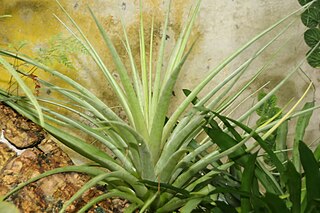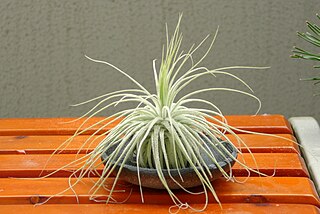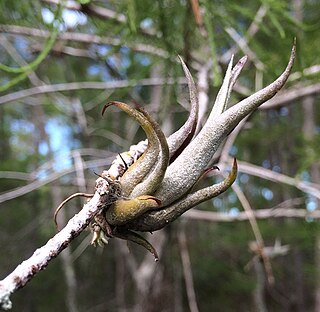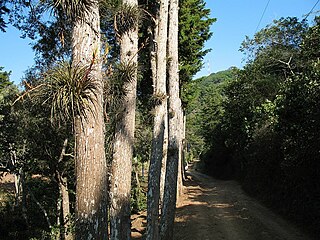
The Bromeliaceae are a family of monocot flowering plants of about 80 genera and 3700 known species, native mainly to the tropical Americas, with several species found in the American subtropics and one in tropical west Africa, Pitcairnia feliciana.

Spanish moss is an epiphytic flowering plant that often grows upon large trees in tropical and subtropical climates. It is native to much of Mexico, Bermuda, the Bahamas, Central America, South America, the Southern United States, and West Indies. It has been naturalized in Queensland (Australia). It is known as "grandpa's beard" in French Polynesia.

Tillandsia is a genus of around 650 species of evergreen, perennial flowering plants in the family Bromeliaceae, native to the forests, mountains and deserts of the Neotropics, from northern Mexico and the southeastern United States to Mesoamerica and the Caribbean to central Argentina. Their leaves, more or less silvery in color, are covered with specialized cells (trichomes) capable of rapidly absorbing water that gathers on them.

Wallisia cyanea, or pink quill, is a species of plant of the genus Wallisia in the bromeliad family, native to the rainforests of Ecuador. An epiphytic perennial growing to 50 cm (20 in) high by 50 cm (20 in) wide, it has stemless rosettes of thin, recurved leaves and paddle-shaped spikes of 20 pink bracts with violet flowers, in spring and autumn.

Tillandsia caput-medusae is a species of flowering plant in the bromeliad family, Bromeliaceae, subfamily Tillandsioideae. Common names include octopus plant and medusa's head. An epiphyte native to Central America and Mexico, T. caput-medusae is a commonly cultivated bromeliad species. The thick, channeled, tapering and twisting leaves are up to 25 cm (9.8 in) long and are covered in fine gray hairs. The rosette of leaves arise from an inflated pseudobulb. Pups are produced after blooming, as is usual with most Tillandsia species.

Tillandsia intermedia is a species of flowering plant in the genus Tillandsia. The species is endemic to western Mexico, reported from Guerrero, Sinaloa, and Jalisco.

Tillandsia balbisiana, common name northern needleleaf, is a species of bromeliad in the genus Tillandsia. This species in native to Mexico, Central America, Colombia, Venezuela, the West Indies, and Florida.

Tillandsia xerographica is a species of bromeliad that is native to southern Mexico, El Salvador, Guatemala and Honduras. The name is derived from the Greek words ξηρός (xeros), meaning "dry", and γραφία (graphia), meaning "writing". It is included in Tillandsia subg. Tillandsia.

Tillandsia capitata is a species of flowering plant in the genus Tillandsia. It is native to Mexico, Honduras, Cuba and the Dominican Republic.

Tillandsia brachycaulos is a species of flowering plant in the genus Tillandsia. It is native to Mexico, Central America, and Venezuela.
Tillandsia carlsoniae is a species of flowering plant in the genus Tillandsia. This species is endemic to Mexico. It is named after the person that discovered it in Chiapas, Margery C. Carlson.
Tillandsia festucoides, commonly known as the fescue airplant, is a species of bromeliad that is native to the Greater Antilles, Mexico, the Cayman Islands, and Central America.

Tillandsia flabellata is a species of flowering plant in the family Bromeliaceae. This species is native to southern Mexico and Central America.

Tillandsia magnusiana is a species of flowering plant in the genus Tillandsia. This species is native to southern and western Mexico, El Salvador, Nicaragua and Honduras.

Tillandsia paucifolia, the potbelly airplant, is a species of bromeliad in the genus Tillandsia. This species is native to Central America, central and southern Mexico, Venezuela, Colombia, the West Indies, and Florida.
Tillandsia pseudobaileyi is a species of flowering plant in the genus Tillandsia. This species is native to Mexico, Guatemala, El Salvador, Honduras, and Nicaragua.

Tillandsia rodrigueziana is a species in the genus Tillandsia. This species is native to Mexico, El Salvador, Nicaragua, Guatemala, and Honduras.

Tillandsia schiedeana is a species of flowering plant in the genus Tillandsia. It was named for the collector Christian Julius Wilhelm Schiede. As an epiphyte, it is found "growing in open tropical forests, and saxicolous, growing on cacti and burseras on steep dry slopes in semiarid regions in Mexico, Central America, West Indies, Venezuela, and Colombia at elevations of 750 to 5,500 feet."
Tillandsia moscosoi is an epiphyte in the genus Tillandsia. It is endemic to the Dominican Republic. It has pale lavender flowers.

Tillandsia ultima is a species of flowering plant in the genus Tillandsia that is native to Colombia and Ecuador. It was first discovered in Colombia in 1946 in the region of Magdalena.

















